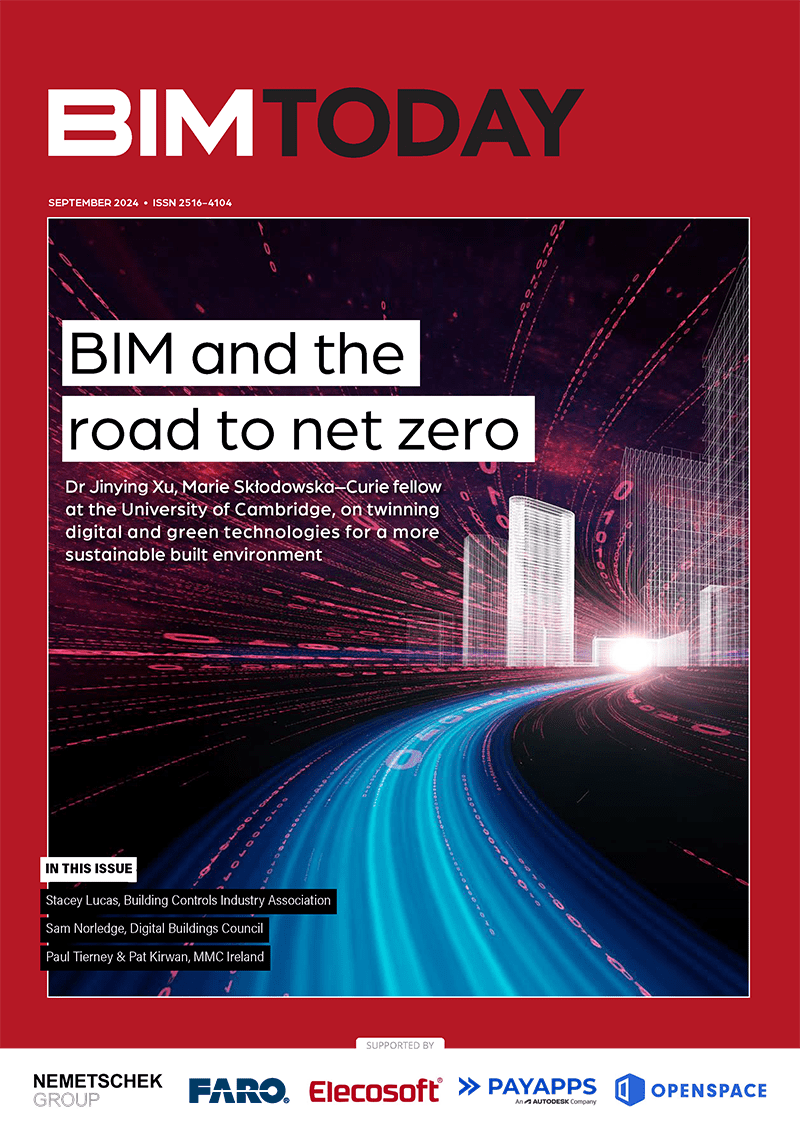Welcome to the September edition of BIM Today, where our expert contributors explore all facets of digital construction, from Building Information Modelling and digital twins to AI, VR and GIS
In the BIM Today September 2024 cover story, Dr Jinying Xu, Marie Skłodowska–Curie fellow in the CSIC Department of Engineering at the University of Cambridge, explores BIM’s role in carbon management.
With efforts underway to reach net zero by 2050, integrating information relating to the carbon footprint of materials, construction processes and operational energy use within BIM models would allow for real-time assessment and optimisation of emissions from design to demolition.
However, there are a number of challenges to overcome, such as the need for standardised carbon data collection methodologies to enhance data comprehensiveness and interoperability, along with regulatory frameworks to support integration.
Stacey Lucas, president of the Building Controls Industry Association, looks at the various ways in which smart buildings can help the built environment reduce its carbon footprint.
Meanwhile, Sam Norledge, head of smart buildings at LMG, a member of the Digital Buildings Council and buildingSMART UK & Ireland, considers how digital twins can break down silos to unlock the wealth of insights hidden in building data.
Elsewhere, Paul Tierney and Pat Kirwan of MMC Ireland make the case for policy support to digitalise and decarbonise construction to help Ireland become a world leader in offsite and modern methods of construction.
Andy Clifton, senior support engineer at Topcon, looks at how going digital supports decarbonising road projects, Martin Huber, CEO of Metaroom by Amrax, discusses why VR and AI visualisation will be key enablers of Britain’s’ retrofit revolution and Phillip Robinson of ITPEnergised examines the new TMO4+ regulations, which aim to accelerate the UK’s net zero transition by 10 years.
We also hear from Dr Jimmy Abualdenien, head of digital twin product at the Nemetschek Group, on building trust with 3D visualisations and digital twins to create “living, breathing” models that enhance collaboration, sustainability and innovation.
Here’s a selection of what’s in store in the September 2024 edition of BIM Today:
1. The role of BIM in carbon management
Dr Jinying Xu, Marie Skłodowska–Curie fellow in the CSIC Department of Engineering, University of Cambridge, looks at how BIM can help to mitigate carbon emissions on the road to net zero.
2. How smart buildings are helping the built environment reduce its carbon emissions
By optimising energy consumption through automation and advanced technologies, smart buildings can play a significant role in reducing carbon emissions. Stacey Lucas, president of the Building Controls Industry Association (BCIA), looks at the various ways in which smart buildings can help the built environment reduce its carbon footprint.
3. Making Ireland a world leader in MMC
Ireland can become a world leader in offsite and MMC, but needs policy support in order to digitalise and decarbonise construction, write Paul Tierney, CEO of MMC Ireland, and Pat Kirwan, chair of MMC Ireland’s Policy & Support Integration working group.
4. Bridging the gap between digital construction and digital operations with twins
Sam Norledge, head of smart buildings at LMG, a member of the Digital Buildings Council and buildingSMART UK & Ireland, looks at how we can break down silos with digital twins to unlock the wealth of insights hidden in building data.
5. How going digital supports decarbonising road projects
Digital workflows have a crucial role to play in decarbonising roads and highways, writes Andy Clifton, senior support engineer at Topcon.
6. Could AI visualisation solve Britain’s great retrofit challenge?
Martin Huber, CEO and co-founder of 3D modelling and spatial data company Metaroom by Amrax, discusses why VR and AI visualisation will be key enablers of Britain’s’ retrofit revolution.
7. Seeing is believing: Building trust with 3D visualisations and digital twins
3D real-time visualisation through digital twins can create “living, breathing” building models that enhance collaboration, sustainability and innovation, writes Dr Jimmy Abualdenien, head of digital twin product at the Nemetschek Group.
8. The pressing need for industry standards in geospatial information
As geospatial information becomes critical for modern construction projects, who is measuring the measurement?
9. Geospatial innovation paves the way for offshore wind
The Crown Estate’s “Whole of Seabed” approach helps plan seabed use around England, Wales and Northern Ireland. Considered a world first, geospatial innovation helps make sense of highly complex and competing demands, driving better planning decisions.
10. The UK BIM Framework: Supporting the Big Three of built environment policy
The Construction Playbook, National Infrastructure Strategy and TIP: Roadmap to 2030 have set the priority areas for the built environment – but productivity remains a key challenge. Dan Rossiter of the Chartered Institute of Architectural Technologists says the UK BIM Framework can support organisations in boosting output, cutting costs and improving sustainability.


